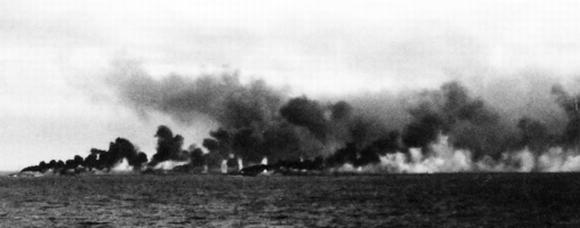 The Battle of Leyte Gulf was fought seventy-five years ago this week between the US and Australian navies and the Imperial Japanese Navy. It was the largest naval battle of World War II and by some standards the largest naval battle in history. Fought between October 23-26, 1944, it was actually a series of battles that spanned over more than 100,000 square miles of sea and involved more than 800 ships and 1,800 aircraft. The battle of Leyte Gulf was a major allied victory and effectively destroyed the Imperial Japanese Navy as a fighting force.
The Battle of Leyte Gulf was fought seventy-five years ago this week between the US and Australian navies and the Imperial Japanese Navy. It was the largest naval battle of World War II and by some standards the largest naval battle in history. Fought between October 23-26, 1944, it was actually a series of battles that spanned over more than 100,000 square miles of sea and involved more than 800 ships and 1,800 aircraft. The battle of Leyte Gulf was a major allied victory and effectively destroyed the Imperial Japanese Navy as a fighting force.
The Battle off Samar, fought on October 25, 1942, seventy-five years ago today, saved the landings at Leyte Gulf from likely destruction. The powerful US Navy 3rd fleet had been lured north by a decoy Japanese force, leaving the Leyte landing beaches protected only by three small escort carrier task forces designated by their call signs, Taffy 1, 2 and 3.
On the morning of October 25th, the escort carrier task force Taffy 3, under the command of Rear Admiral Clifton Sprague, was surprised by the arrival of a Japanese fleet of 23 ships, consisting of 4 battleships, 6 heavy cruisers, 2 light cruisers, 11 destroyers, commanded by Admiral Kurita. Among the fleet was the Yamoto, one of two of the largest battleships ever built. To face the Japanese, Sprague’s task force had only 3 destroyers and 4 destroyer escorts to defend 6 escort carriers.
Escort carriers also called “jeep-carriers” or “baby-flattops” were typically half the size of fleet carriers. They carried fewer planes, were slower, and less heavily armored than the larger carriers.
Sprague immediately sent the carriers east to attempt to escape, while sending the carrier planes aloft. The destroyers and destroyer escorts made smoke to attempt to hide the carriers. The destroyers dodged the long-range fire of the battleships and heavy cruisers to make torpedo runs. The destroyers escorts followed in a second wave against the overwhelming Japanese force.
Based on the intensity of the attack by the American destroyer and destroyer escorts, Admiral Kurita was convinced that he was engaging a much larger carrier force. This was reinforced by the aerial attacks from the Taffy 3 carrier planes, which were joined by planes from Taffy 2 during the battle. Because the Taffy 3 planes were caught preparing to support the Leyte landing, they weren’t armed to attack battleships. The Taffy 2 planes, however, were armed with torpedos and 500-pound bombs, which were a threat to the Japanese. Admiral Kurita decided to break off the attack and steam northwest.
Despite being outnumbered and outgunned, the seven destroyers and destroyer escorts sank 3 Japanese heavy cruisers and damaged 3 heavy cruisers and 1 destroyer. The cost was high, however. Of the 3 US destroyers, 2 were sunk and one was damaged. One of the destroyer escorts was sunk and 2 were damaged. In the attack, 2 escort carriers were sunk and 4 were damaged. Over a thousand Americans died, comparable to the combined losses of American men and ships at the Battles of the Coral Sea and Midway.
Of the battle, Carsten Fries writes: The initiative, aggressiveness, and outright heroism demonstrated by Taffy 3, combined with determined U.S. naval air attacks, limited Japanese situational awareness, and pure dumb luck of the Americans had stymied Vice Admiral Kurita’s intent to destroy U.S. landing forces in the Leyte Gulf. Along with the defeats in the Sibuyan Sea, the Surigao Strait, and off Cape Engaño, the Samar engagement blunted or destroyed much of the Japanese navy’s remaining offensive capabilities and turned its surviving surface forces into a “fleet in being”—a concern for Allied commanders, but never again the threat it had still posed into early 1944.
